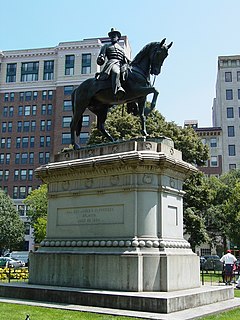
McPherson Square is a square in downtown Washington, D.C. It is bound by K Street Northwest to the north, Vermont Avenue NW on the East, I Street NW on the south, and 15th Street NW on the West; it is one block northeast of Lafayette Park. It is the sister square of Farragut Square two blocks west.and is served by the McPherson Square station of the Washington Metro.

Freedom Plaza, originally known as Western Plaza, is an open plaza in Northwest Washington, D.C., United States, located near 14th Street and Pennsylvania Avenue NW, adjacent to Pershing Park. The plaza features an inlay that partially depicts Pierre (Peter) Charles L'Enfant's plan for the City of Washington. The National Park Service administers the Plaza as part of its Pennsylvania Avenue National Historic Site and coordinates the Plaza's activities.
The Partnership for Civil Justice Fund (PCJF) is a nonprofit progressive legal organization based in Washington, D.C. Founded by Carl Messineo and Mara Verheyden-Hilliard, the organization focuses on cases regarding free speech and dissent, domestic spying and surveillance, police misconduct, and government transparency.

Occupy Los Angeles is one of the many occupy movements in the United States, following the original Occupy Wall Street (OWS) protest. Participants of Occupy L.A. first met at Pershing Square on September 23, 2011. Activists came to consensus to occupy public space in solidarity with the growing movement. Occupiers first marched in Los Angeles on September 24, 2011. They next protested a fundraiser being held in Hollywood at the House of Blues for President Obama. Participants met at Pershing Square every subsequent night to plan out the logistics of an occupation set to begin on October 1, 2011. After debating potential locations around Los Angeles, people decided on the lawns around City Hall. Tents first manifested on October 1, 2011 on the grounds of Los Angeles City Hall.

The following is a timeline of Occupy Wall Street (OWS), a protest which began on September 17, 2011 on Wall Street, the financial district of New York City and included the occupation of Zuccotti Park, where protesters established a permanent encampment. The Occupy movement splintered after NYC Mayor Bloomberg had police raid the encampment in Zuccotti Park on November 15, 2011. The timeline here is limited to this particular protest during this approximate time-frame.

Occupy Portland was a collaboration that began on October 6, 2011 in downtown Portland, Oregon as a protest and demonstration against economic inequality worldwide. It is inspired by the Occupy Wall Street movement that began in New York City on September 17, 2011.

Occupy Seattle was a series of demonstrations in Seattle, Washington, United States in 2011 and 2012, that formed part of the wider Occupy movement taking place in numerous U.S. and world cities at that time. The demonstrations were particularly focused on the city's downtown area including Westlake Park and Seattle City Hall; their stated aim was to oppose wealth inequality, perceived corporate greed, and corruption in the banking and economic systems of the United States.
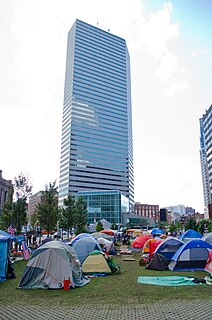
Occupy Boston was a collective of protesters that settled on September 30, 2011 in Boston, Massachusetts, on Dewey Square in the Financial District opposite the Federal Reserve Bank of Boston. It is related to the Occupy Wall Street movement that began in New York City on September 17, 2011.

The Occupy movement was an international populist socio-political movement that expressed opposition to social and economic inequality and to the lack of perceived "real democracy" around the world. It aimed primarily to advance social and economic justice and different forms of democracy. The movement has had many different scopes, since local groups often had different focuses, but its prime concerns included how large corporations control the world in a way that disproportionately benefits a minority, undermines democracy and causes instability.

Occupy Buffalo was a collaboration that included a peaceful protest and demonstrations which began on October 1, 2011, in Buffalo, New York, in Niagara Square, the nexus of downtown Buffalo opposite the Buffalo City Hall. It is related to the Occupy Wall Street movement that began in New York City on September 17, and called for economic equity, accountability among politicians and ending lobbyist influence of politicians. Protesters camped overnight in Niagara Square as part of the demonstration.
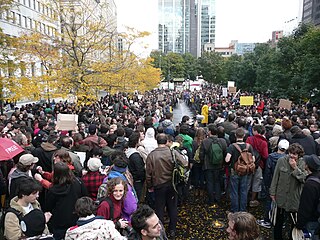
Occupy Canada was a collective of peaceful protests and demonstrations that were part of the larger Occupy Together movement which first manifested in the financial district of New York City with Occupy Wall Street, and subsequently spread to over 900 cities around the world.
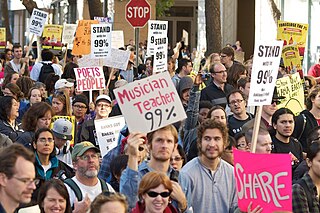
Occupy Oakland refers to a collaboration and series of demonstrations in Oakland, California that started in October 2011. As part of the Occupy movement, protestors have staged occupations, most notably at Frank H. Ogawa Plaza in front of Oakland City Hall.

Occupy Melbourne was a social movement which took place from late 2011 to mid 2012 in Melbourne, Australia as part of the global Occupy movementParticipants expressed grievances concerning economic inequality, social injustice, corruption in the financial sector, corporate greed and the influence of companies and lobbyists on government. Protests began on 15 October 2011 in City Square with a 6-day-long protest encampment, from which people were forcibly evicted by Victoria Police at the request of the City of Melbourne CEO on 21 October 2011. From 2 November 2011, Occupy set up camp in Treasury Gardens before being moved on from that location in December. A significantly diminished number of protesters set up camp at Father Bob's church at his invitation until his retirement in January 2012. Physical manifestations of the movement had largely dissipated by mid-2012 though it adopted a strategy of decentralisation and became influential in the creation of new community networks, affinity groups and collectives.

Occupy San Francisco was a collaboration that began with a demonstration event located at Justin Herman Plaza in the Embarcadero and in front of the Federal Reserve building on Market Street in the Financial District in San Francisco, California. It is based on the Occupy Wall Street movement that began in New York City on September 17, 2011 and is one of several "Occupy" protest sites in the San Francisco Bay Area; other sites include Occupy Oakland and Occupy San Jose.

The Occupy movement began in the United States initially with the Occupy Wall Street protests in New York City, but spread to many other cities, both in the United States and worldwide. This list article is an alphabetical, non-chronological summary of Occupy events that have occurred in cities in the United States.

Occupy St. Louis (OccupySTL) was a postpartisan people's movement that began on October 1, 2011 as a peaceful protest against corporate greed, its influence over the economy, its corruption of government, and ensuing inequality. Although people possess differing viewpoints and diversity of views is a central tenet, commonly held themes seek an equal playing field in the economy with more equal opportunities for all people as well as accountability for corporate and financial malfeasance. Many of those in the movement argue that structural, systemic change is necessary and that incremental reform is insufficient and in any case not possible without popular countervailing power to the power of moneyed interests. Occupy St. Louis is in solidarity with the Occupy Wall Street movement. It is located at Kiener Plaza in downtown St. Louis near an area which includes many financial institutions such as commercial banks and the Federal Reserve Bank of St. Louis.
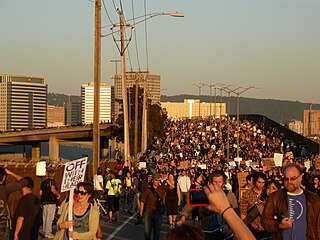
The following is a timeline of Occupy Oakland which began on Monday, October 10, 2011, as an occupation of Frank H. Ogawa Plaza located in front of Oakland City Hall in downtown Oakland, and is an ongoing demonstration. It is allied with Occupy Wall Street, which began in New York City on September 17, 2011, and is one of several "Occupy" protest sites in the San Francisco Bay Area. Other sites include Occupy San Francisco and Occupy San Jose.

Occupy Baltimore was a collaboration that included peaceful protests and demonstrations. Occupy Baltimore began on October 4, 2011, in Baltimore, Maryland, in McKeldin Square near the Inner Harbor area of Downtown Baltimore. It is one of the many Occupy movements around the United States and worldwide, inspired by Occupy Wall Street.

Occupy Minneapolis [OccupyMN] is a grassroots collaboration that began in October 2011 with a series of demonstrations in Minneapolis, Minnesota. Protesters have staged numerous occupations, most notably of the Hennepin County Government Center plaza.

Adam Eidinger is a Washington D.C. businessman and cannabis rights activist, known for his role in spearheading Initiative 71, which legalized cannabis in the District of Columbia in 2015.



















